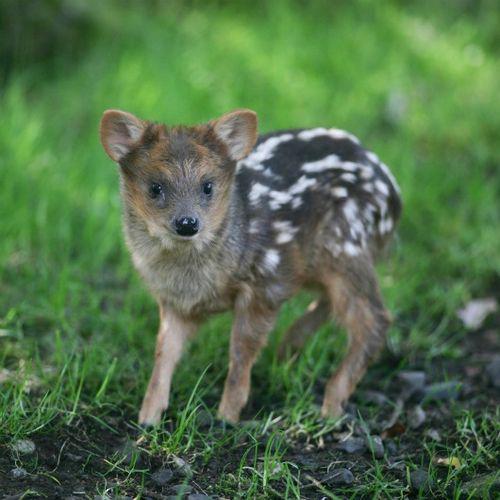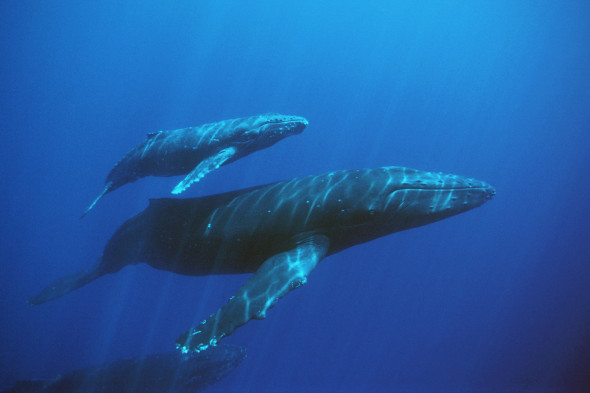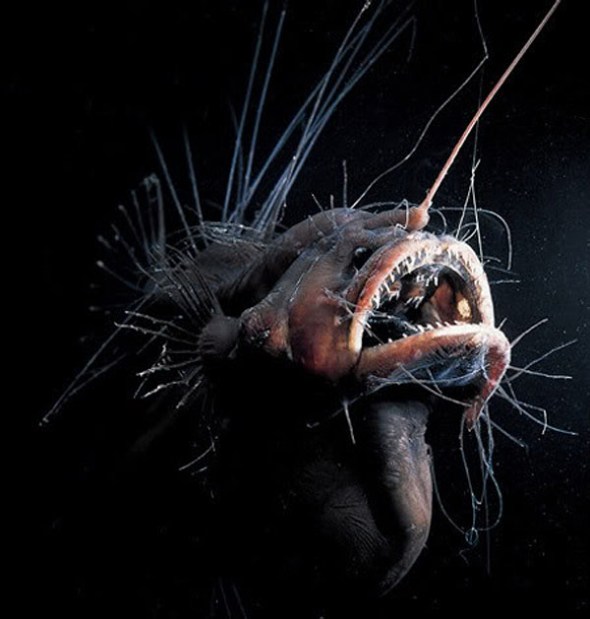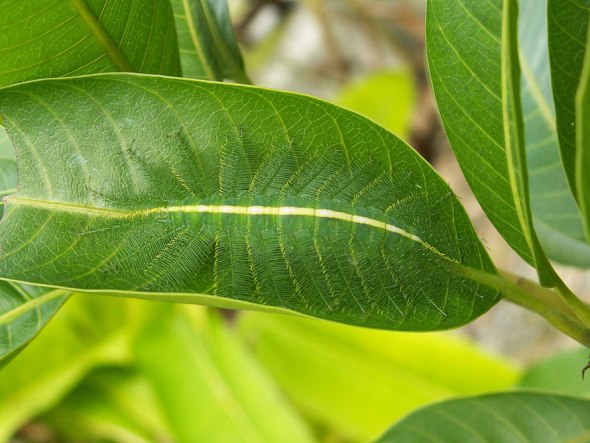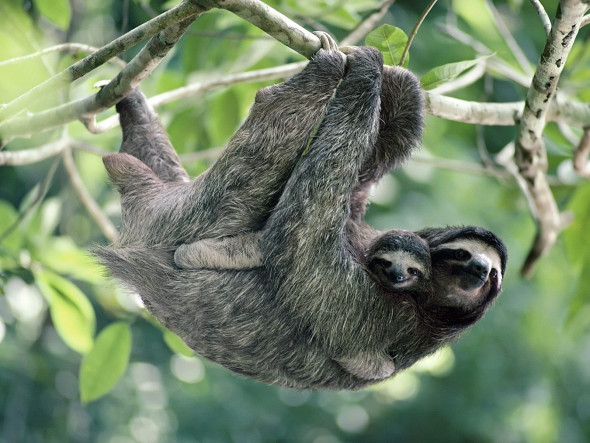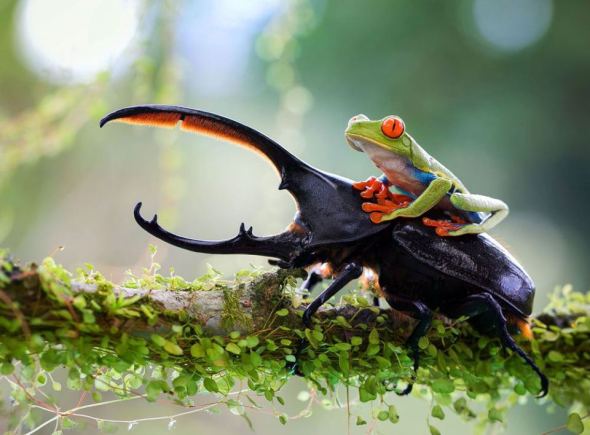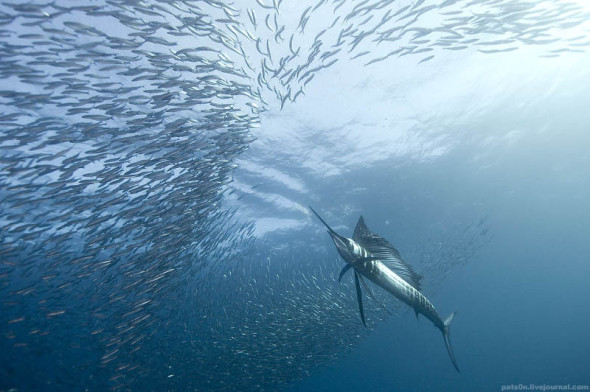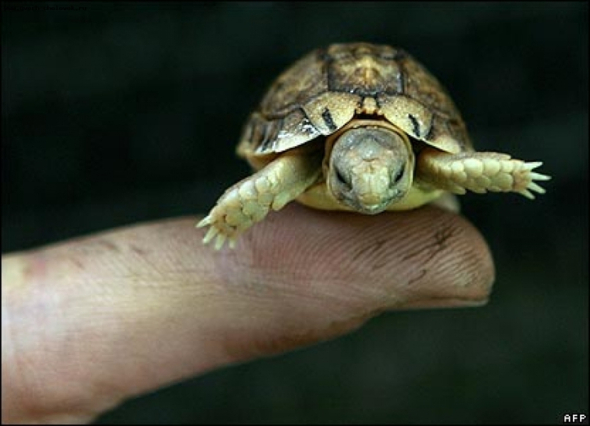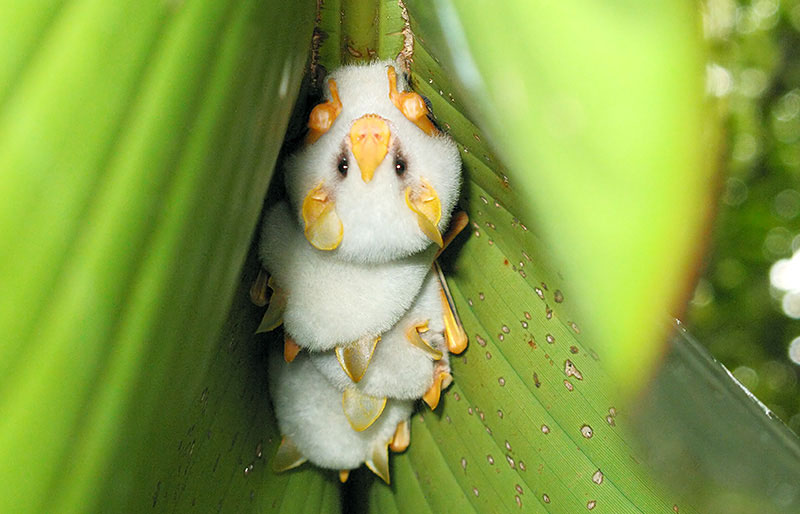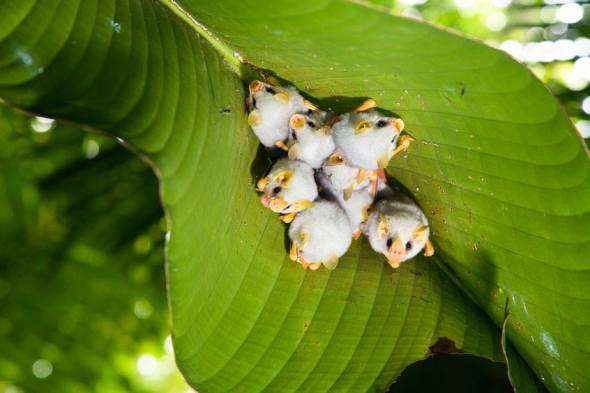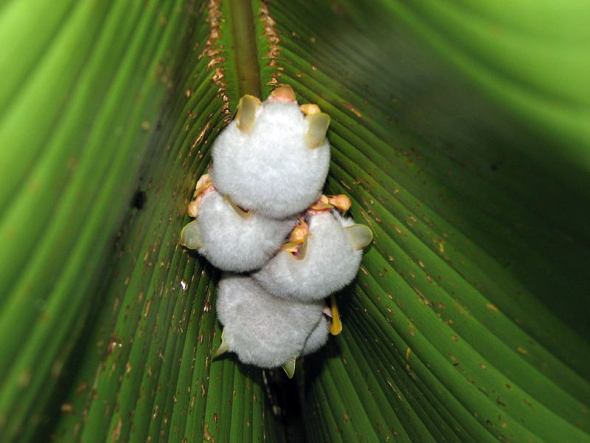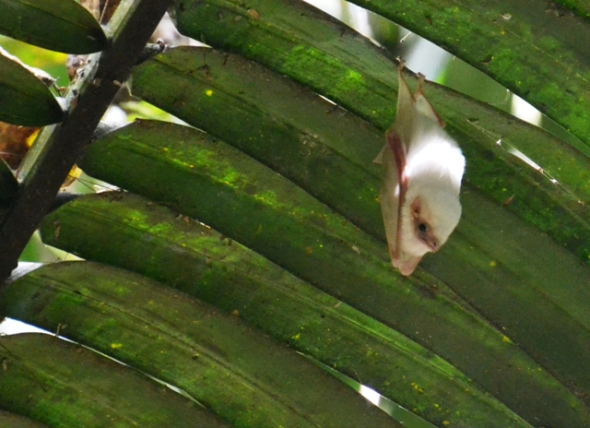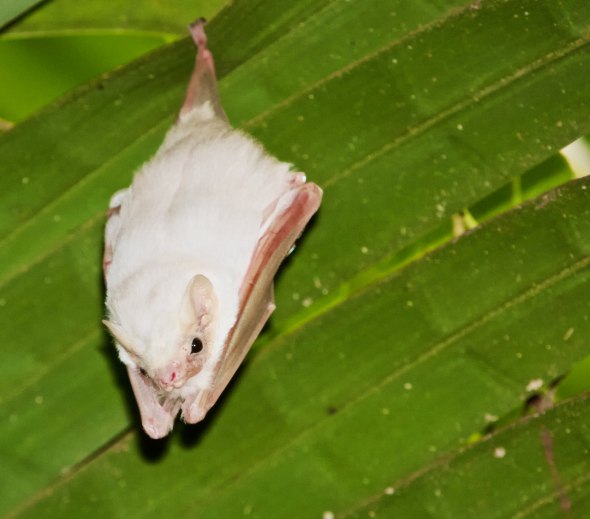Animal Planet - Mother Natures Finest
Mother Nature hides many secrets that we as humans are still fully unaware of. Below is a quick run down of Mother Natures finest specimens of animals that International Animal Rescue Foundation has picked for your information.
In at number one is the smallest deer in the world.
Pudus Deer;
Endangered
The pudús are the world’s smallest deer, with the southern pudú being slightly larger than the northern pudú. It has a stocky frame supported by four short and slender legs. It is 32 to 44 cm (13 to 17 in) high at the shoulder and up to 85 cm (33 in) in length. Pudús normally weigh up to 12 kg (26 lb), but the highest recorded weight of a pudú is 13.4 kg (30 lb). Pudús have small, black eyes, black noses, and rounded ears with lengths of 7.5 to 8 cm (3.0 to 3.1 in). Sexual dimorphism in the species includes an absence of antlers in females. Males have short, spiked antlers that are not forked, as seen in most species of deer. The antlers, which are shed annually, can extend from 6.5 to 7.5 cm (2.6 to 3.0 in) in length and protrude from between the ears. Also on the head are large preorbital glands. Pudús have small hooves, dewclaws, and short tails about 4.0 to 4.5 cm (1.6 to 1.8 in) in length when measured without hair. Coat coloration varies with season, gender, and individual genes. The fur is long and stiff, typically pressed close to the body, with a reddish-brown to dark-brown hue. The neck and shoulders of an aged pudú turn a dark gray-brown in the winter.
In at number two is the loudest animal on the planet the Blue Whale;
Endangered
The blue whale is the loudest animal on the face of the earth. However not far off from the this mega beast is the second loudest animal on the planet being that the Howler Monkey.
The call of the blue whale reaches levels up to 188 decibels. This extraordinarily loud whistle can be heard for hundreds of miles underwater. Theoretical calculations by Roger Payne and Douglas Webb (from the 1970’s) predicted that the loudest whale sounds might be transmitted across an entire ocean. The blue whale is much louder than a jet, which reaches only 140 decibels! Human shouting is 70 decibels; sounds over 120 decibels are painful to human ears. The second-loudest animal on Earth is the howler monkey (Alouatta) from the jungles of Central and South America.
In at number three is the Honduran White Bat;
The only white bat on the face of the planet of which is just that “white” and not albino. Whats so special about the Honduran White Bat though other than its white? Well its the only bat that doesn’t actually live within caves, more rather under heliconia leaves.
Near threatened
The Honduran white bat cuts the side veins extending out from the midrib of the large leave of the Heliconia plant causing them to fold down to form a ‘tent’. They cling to the roof of this tent in small colonies of up to half a dozen individuals, consisting of one male and a harem of females. The tent protects them from rain and predators. Most tent-making bats take flight at even slight disturbances, but researchers in Costa Rica have reported that Honduran white bats take flight only when the main stem of their tent is disturbed, possibly because they are well camouflaged. Although their tents are typically low to the ground (about six feet), sunlight filters through the leaf which gives their white fur a greenish cast. This almost completely conceals them if they remain still. It has been suggested a colony may have a number of tents scattered within the forest. It is one of 15 species of Latin American bats that roost in tents. In the Old World, 3 species of bat from India and Southeast Asia are known to roost in tents.
In at number four is the angriest looking animal on the planet, the Angler Fish;
IUCN Red List - Unknown
In the darkest depths of the ocean where the water is freezing cold, the pressure is enormous and food is scarce lives the angry-looking deep sea anglerfish. This fascinating fish is not only an incredible example of how organisms manage to survive in the most inhospitable environments, it has one of the most bizarre ways of reproducing in the animal kingdom. The deep sea anglerfish is one of the deep ocean’s most fascinating residents. Living at the extreme depths between 1.5 and 2.5 km, their most peculiar appearance is a modified fin that acts as a lure, hanging above their huge mouths containing needle-like teeth. The tip of this “fishing rod” on top of their head is bioluminescent (glowing in the dark) because of bacteria living inside it and attracts prey in a similar way like moths to a lightbulb. By wiggling the glowing outgrowth, it lures prey close enough to devour them whole. Because of thin, soft bones and jelly-like skin, these scary looking fish can expand their jaws and stomach to such an extent that they are even able to actually swallow prey up to twice their own size. In the deep sea where food is very scarce, being able to eat large quantities at once is a great adaptation. Now that’s pretty awesome but weird yet wonderful too..
In an number five is the worlds most camouflaged animal the Common Baron Caterpillar;
IUCN Red List - Unknown
Just take a closer look at the image below. Do you see anything besides a leaf? If you look closer you can catch a glimpse of a tiny little fellow called, the common baron caterpillar. Feeding mostly on mango and cashew nut trees during its larvae stage; they remarkably camouflage themselves and seemingly disappear into foliage. We are sympathizing for the birds which don’t get a chance to swoop on them. However, as soon as they evolve from larvae to butterfly stage, they lose their camouflaging ability. The common baron caterpillars are native to India and Southeast Asia. The males are brown with slight tinges of olive, whereas the females are of paler shades. Their camouflage of course boosts their chances survival. When the common baron caterpillar goes through all stages of life they eventually metamorphose into a butterfly called the common Baron, which is a medium-sized the ‘nymphalid butterfly’. Now this is one species of animal the armed forces need to take a leaf out of “its” book. And no the photograph is not edited.
In at number six the slowest (mammal) on the planet, the Three Toed Sloth;
Near threatened
The three-toed sloth is the slowest mammal on Earth, due to its lack of muscle tissue.It is so sedentary that algae grows on its furry coat. All sloths are built for life in the treetops. The three-toed sloths are tree-living mammals from South and Central America. They are the only members of the genus Bradypus and the family Bradypodidae. The four living species of three-toed sloths are the brown-throated sloth, the maned sloth, the pale-throated sloth, and the pygmy three-toed sloth.. And just to give you a brief glimpse into the sheer speed of the three toed sloth - they travel at a distance of 0.15 kilometers per hour.
In at number seven is the worlds strongest insect, stand aside Mr leaf cutting ant as your title has been beaten. Meet the Rhinoceros Beetle;
IUCN Red List - Unknown
Rhinoceros Beetles can lift 850 times their own weight. To put this into perspective, if a human had the strength of the rhinoceros beetle, it would be able to lift a 65 ton object. If the mighty elephant had equal strength to the rhinoceros beetle it would be able to carry 850 elephants on its back.
The Hercules beetle (Dynastes hercules) is the most famous and the largest of the rhinoceros beetles. It is native to the rainforests of Central America, South America, and the Lesser Antilles. The beetle has also been observed as far north as Southern Veracruz in Mexico. Their title is well deserved, with some able to lift more than 850 times (up to 8 kg lifted) their own weight and some males, rarely, reaching 17 cm (6.75 inches) in length. It is the largest of the six species in the Dynastes genus, and one of the largest beetles known, being exceeded in length by only two other beetles in the family Cerambycidae, Macrodontia cervicornis (specimens of 17–17.5 cm are known) and Titanus giganteus (also up to 17–17.5 cm; several 18+ cm specimens are reputed/alleged to exist). However, if the horns are excluded, both M. cervicornis and D. hercules drop considerably farther down in the size rankings, leaving T. giganteus on top. One reason for this is that the development of the horns is allometric, as well as sexually dimorphic, and thus not strictly correlated to actual body size; it is possible for a female to be much longer, measured from eyes to abdomen, than a male, yet be considered “smaller” simply due to the absence of horns. Worlds strongest man - step aside the title is lost. Picture - This is the moment a red-eyed Costa Rican tree frog hitched a lift on a giant Hercules beetle.
In at number eight the worlds fastest marine mammal the Sailfish;
IUCN Red List - Unknown
Sailfish are the fastest fish in the ocean and have been clocked leaping out of the water at more than 68 mi (110 km) per hour. Size relative to a 6-ft (2-m) man: The two main subspecies of sailfish, Atlantic and Indo-Pacific, range throughout the warm and temperate parts of the world’s oceans.
Sailfish are two species of fishes in the genus Istiophorus, living in warmer sections of all the oceans of the world. They are blue to grey in color and have a characteristic erectile dorsal fin known as a sail, which often stretches the entire length of the back. Another notable characteristic is the elongated bill, resembling that of the swordfish and other marlins. They are therefore described as billfish in sport fishing circles. Both species of sailfishes grow quickly, reaching 1.2-1.5 m (4-5 ft) in length in a single year, and feed on the surface or at mid-depths on smaller pelagic forage fish and squid. Individuals have been clocked at speeds of up to 110 km/h (70 mph), which is the highest speed reliably reported in a fish. Generally, sailfish do not grow to more than 3 m (10 ft) in length and rarely weigh over 90 kg (200 lb), although larger specimens have been seen off the shores of Costa Rica.
In at number nine is the worlds smallest tortoise;
Near Threatened
Speckled Padloper Tortoise: the smallest tortoise in the world is found in South Africa. The itty bitty tortoises grow up to 8-10cm in length. The speckled tortoise (Homopus signatus), known locally as the speckled padloper, and also known internationally as the speckled cape tortoise, is the world’s smallest tortoise. A member of the genus Homopus, it is endemic to South Africa and Southern Namibia. Small but cute, please do not remove them from the wild. These species of tortoise are near threatened.
In at number ten - Killer Siafu Ants;
IUCN Red List - Non-Concern
The legends are well known to people across the world; swarms of destructive ants which consume any creature slow or daring enough to remain within their range, even humans. They overcome their prey, stinging and biting from all sides. In the case of sufficiently large prey, they enter the nasal passages and mouth of the victim and kill it through asphyxiation. The corpse is sliced up into manageable pieces by the powerful mandibles of the insects and carried back to their nest. The stories depict infants and old people as the victims of these ants. The insects invade at night, when most people are asleep, and attack their victims. By the time the prey wakes up, they are completely engulfed by the ants and under attack via bites and stings. The end results are commonly tragic and unsightly. Of course this is somewhat little exaggerated, however not as exaggerated as you may think.
These tales tend to be exaggerated and used as inspirations for grisly scenes in science fiction films. However, unlike urban legends, these stories possess a frightening level of reality. There are indeed cases of humans being killed and consumed by ants. The thought of such a death is too much for most to imagine as it would be a very slow and torturous death. These cases, however, are rare. There are not too many reported deaths of such a magnitude, and even general human kills of any sort are low in number compared to other animal attacks. However, a human must not be killed by these insects in order to understand their hunting prowess. Dangerous ants demand respect due to the fact that they can become a threat to nearly any other creature in their environment. These interesting and social animals deserve more positive attention than they sometimes receive. The surprising level of teamwork found in their colonies and their ability to become powerful enough to kill anything in their path certainly set them aside from most other creatures except for perhaps man. Certain species have caught man’s eye as being particularly dangerous. Among them will be the species discussed;
Siafu ants (Genus Dorylus) are some of the most well known ants in the world. They are considered a menace due to their combination of an aggressive nature and massive colonies. Their range extends from central Africa to portions of Asia. They are known for living in colonies of up to 20,000,000 or so ants and are commonly documented taking part in great marches in search of food or a new settlement location. Soldiers exist among the species, possessing both stingers and powerful mandibles which rarely let go once they grab onto prey or an enemy. In fact, African tribes have used the ants as sutures; they grab an individual ant and press its mandibles to a small gash in such a way that the ant’s jaws clamp onto both sides of the wound and close it. The ant’s body is then crushed off and only the head remains, still holding the wound area together. Although painful, it is surprisingly effective and has become a useful method of wound treatment for the tribes. This makes the ants useful for some people. The ants also function as pest regulators, killing of some of the local pest population during their common raids. However, the ants and humans don’t always share such a pleasant relationship. It is the Siafu ants that have also become well known for being man eaters. This occurs when the ants march too closely to villages or settlements of any sort. Sleeping prey, human or animal, sometimes awaken to a barrage of stings and painful bites. The end result can easily become a terribly painful death. These deaths, as unfortunate and gruesome as they are, are simply the side effects of living in the Siafu’s range.
These ants can take down almost any creature that is unable to escape their path in time. Snakes, turtles, various insects, and many small mammals commonly fall prey to the Siafu. Also, as mentioned before, larger animals and people can also become food items for the insect army. Once brought down, the prey is sliced up into portable chunks which are carried back to the nest and stored for later consummation. These marches are nearly unstoppable, and most animals would do well to step aside and stay far away from these troops.
However, there is more to the Siafu than killing and death. They are misunderstood, much like many other predatory animals. The ants must protect their colony at all costs. This is especially true in times of travel, where the ants are most vulnerable. They must take whatever prey is made available to them, for the sake of their colony’s nourishment as well as the legacy of their family. When one studies their behavior, a surprising level of care and detail is found. For example, in order to protect the smaller ants during travel, soldier Siafu form “highways” which cover and surround the weaker ants as they march onwards. The soldiers wave their jaws around from the outer side of this protective covering so as to intimidate any passing animals.
Enjoy your weekend
International Animal Rescue Foundation Africa
International Animal Rescue Foundation
Honduran White and Northern White Bat.
Some have stated they resemble the appearance of Furbies while others sate they look like cute little Gremlins. Well actually they are indeed Honduran Ghost Bats, commonly named as the (Honduran White Bat) that we featured on our main International Animal Rescue Foundation Endangered Species Article few days ago that we release every Monday and Friday.
The Honduran White Bat just one of two unique species of white bat that inhabits planet Earth featured this week on our Endangered Species Post as they are currently listed as (near threatened). Scientifically named as Ectophylla alba populations of this very small (pygmy) style bat are on the decline. To what extent we are still unaware. Data on diet, population trend and behavior is limited.
White bats like all bats fall into the order of Chiroptera. Chiroptera is an ancient order of mammalia dating to the early Eocene, including the bats. They are nocturnal mouselike mammals having four toes of each of the anterior limbs elongated and connected by a web, so that they form membranous wings that can be used in flying. They also have anatomical adaptations, including large ears, for echolocation, by which they navigate and in some cases find insects. The order includes the suborders Megachiroptera (the fruit bats) and Microchiroptera (insectivorous bats). See Bat. Previously spelled cheiroptera.
Identified back in 1892 by Dr Joel Asaph Allen (July 19, 1838 – August 29, 1921) was an American zoologist and ornithologist. Dr Allen was one of worlds leading and most professionally sound experts in zoology and ornithology of which his work is still spoken about to this very day at many universities globally.
Allen was born in Springfield, Massachusetts. He studied at Harvard University under Louis Agassiz, and took part in Agassiz’s 1865 expedition to Brazil in search of evidence of an ice age there, which Agassiz later claimed to have found, and in others within the United States. Allen later crossed into Honduras and Panama in search of the elusive Honduras white bat.
Native to Costa Rica, Honduras, Nicaragua and Panama the Honduras White Bat has very few major threats. This doesn’t though for one minute mean its very few threats are indeed large to the species of Honduras White Bat. Populations are rapidly declining like many bat species internationally. The Honduras White Bat have habitat preference. In Costa Rica the population declined, food preference and habitat restriction is known.
Habitat fragmentation, forest clearance, poaching and trade are known “threats” to both species of white bat found exclusively within this area of the world. However little documentation has been compiled to indicate just how bigger threats these pose. International Animal Rescue Foundation World Action Brazil did back in 2012 monitored the Ectophylla alba of which noted land clearance and deforestation, timber trade posing as a significantly increased threat to “some fruit trees that the bat feeds from (again little data was compiled). The primary food source of the Honduran White Bat is fruit of which some food sources are being threatened with intense agriculture and land clearance to cope with human population inclines.
The Honduran White Bat is unique among most bats (but not many tropical bats) in that it will modify its immediate surroundings for its own benefit. Unlike the misconception that all bats live in caves, this bat will use the leave of the large Heliconia plant to form a tent.
It does so by cutting the side veins of the plant that extend out from the midrib; this causes the leaf to droop along the stem, making a tent. The little white bats then cling to the inner plant upside-down in small colonies of around six, although larger groupings have been reported. Unlike most bats that do make tents – the Honduran White Bat will not flee if disturbed lightly by looking under the leaf – they will only flee when the stem itself is disturbed causing a brief flurry of activity.
The advantage of having their white fur is postulated to be the reason – as when sunlight filters through the leaf they look green, and so by not moving they will go un-noticed by possible predators from below. We do not know of any other species of bat or bird that (mimics) its surroundings to protect itself from predation as the Honduran White Bat species does.
Within the last ten years there has been a decline of some thirty per cent of Honduran White Bat populations of which falls under the classification of (near threatened). Ectophylla alba is not known to be common.
Roosting in groups of 4 to 8 in tents and found mainly in (protected areas) the Honduran White Bats are also known to inhabit the Caribbean low lands too at a level of 700m.
Little did we know when publishing the article (Monday 1st September 2014) on the white bat did some 100,000 people and counting not even realize this bat existed, even among some high profile bat enthusiasts which is of some concern to us because the species is listed as near threatened. with a population decline still ongoing its articles such as these that need further exposure in the hope of encouraging others to document on the species and increase awareness in the hope that it will furthermore halt declines and preserve the Honduran White Bat for many hundreds of years to come.
Honduran White Bats are uncommon but local of which threats to the species are listed only in brief. Both males and females construct the tent by biting the leaf veins and pulling the leaf into shape. At the end it always looks like an upside-down boat. They only use seven types of plants for their shelters, and most tents are built in two different kinds of Heliconia species. A good tent- leaf has to be less than 2 m (6 feet) high. Probably to avoid high temperatures in the roost during the day, tents are built where the canopy is nice and thick, although the plant species used for tent building grow under thick as well as under more open canopy. Another important characteristic of useful leaves is that there are only few plants underneath, which is the bats’ way to avoid having predators sneak up to their roost. Honduran white bats only use fresh, new leaves to build their tents, probably because they are undamaged and still softer and therefore easier to bite. After all, these bats are tiny; the body is barely bigger than a nice juicy cherry. Thus the leaves cannot be too tough for the bats to be able to modify them. (see picture below).
Because of these preferences for roosts, Honduran white bats live primarily in mature secondary forests. Very young forests are unsuitable for the bats because they have a very thick understory and an open canopy, whereas mature forests have very few suitable tent plants. But even though secondary forests are common where Honduran white bats occur, the bats are vulnerable to habitat loss because they have very specific needs with respect to roosts. Therefore, continued conversion of forests to agricultural areas will decrease the options for Honduran white bats. (see video below for further information)…
Major threats to our Honduran White Bat is known to be (habitat restriction) that can be anything from deforestation, habitat loss from unsustainable agricultural practices and legal timber trade. Slash and burn techniques although not documented would most likely be a factor that would/could see the species placed in danger furthermore too.
So what do we know about threats associated with the Honduran White Bat? Lets take a look.
Deforestation is a primary threat to many species of wildlife within Costa Rica, secondary threats to white bats could well be the decline of its own roosting plant the Heliconia from which the Honduran bat uses as a safe roost making a well woven tent to keep up to twenty bats a time safe from predators.
Deforestation;
Deforestation is a major threat to biodiversity and ecosystems in Costa Rica. The country has a rich biodiversity with some 12,000 species of plants, 1,239 species of butterflies, 838 species of birds, 440 species of reptiles and amphibians, and 232 species of mammals, which have been under threat from deforestation. Costa Rica is home to the majority of white bast species.
Deforestation in Costa Rica has a serious impact on the environment and therefore may directly or indirectly contribute to flooding, desertification, sedimentation in rivers, loss of wildlife diversity, and the obvious sheer loss of timber. Since the end of World War II, approximately 80% of the forests of Costa Rica have disappeared. Approximately 20,000 acres (8,100 ha) of land are deforested annually; in the 1990s the country had one of the worst deforestation rates in Central America.
As the population grew, the people of Costa Rica cut down the forests to provide for pastureland for cattle ranching to produce beef for the world market to raise revenue. Since the 1950s, approximately 60% of Costa Rica has been cleared to make room for cattle ranching. The problem was worsened because during the 1960s, the United States offered Costa Rican cattle ranchers millions of dollars in loans to produce beef. The deforestation of Costa Rica’s tropical rain forests as in other countries is a threat to life worldwide with a profound effect on the global climate. Soil erosion has increased with deforestation with the topsoil washed away from the hills into the streams and out into the oceans, year after year.
Over half of Costa Rica’s existing forest cover today is under the protection of national parks, biological reserves, or wildlife refuges. However, the major problem in regards to deforestation is the privately owned plots which occupy the other half. Lenient laws on land and amendments to forestry law makes it easy to obtain logging concessions as owners exploit the land to maximise income.
As logging companies enter these forests to exploit them, they require access roads to transport the timber. While cattle ranching is by far the primary cause of deforestation in Costa Rica, banana plantations have also significantly contributed to the problem. Lowland rainforest has been most affected where 130,000 acres (530 km2) of previously forested land (primarily in the Atlantic and Northern regions) have been removed.
Such industries have been synonymous with health risks, notably the high levels of toxic pesticides which affected thousands of plantation workers throughout Central America in the 1970s. Pesticides used to grow bananas and other fruits such as mangoes and citrus fruit may enter the hydrological systems and contaminate the water. The removal of the forest to make way for these fruit planatations may also disrupt the nutrient balance in the soil and through monoculture exhaust the soils and render them unsustainable.
Although most of the larger plantations in Costa Rica are owned by large companies, often multinationals, population pressure in Costa Rica has increased the demand for land among farmers who are forced to venture out onto new land to deforest and farm and compete over scraps of land. While certain conservation laws have been passed in Costa Rica, the government lacks the resources to enforce them.
Light Pollution;
Light pollution could affect the regeneration of tropical rainforests because it disrupts the behaviour of seed dispersing bats, a study suggests. Researchers found that a species of fruit-eating bats in Costa Rica avoided foraging in artificial light. The team warned the findings suggested light pollution could have a negative impacts on ecosystems, and called for light-free refuges to be established. The findings have been published in the Journal of Applied Ecology.
Each year, large swaths of rainforest are cleared and converted to agricultural land. The team says the land is often abandoned when the soil fertility falls, making it uneconomic to grow crops. The team observed: “Natural succession of abandoned land could counter the loss of biodiversity, but the rate of natural reforestation is slow.” They added that fruit-eating bats help rainforest plants re-colonize the land because the mammals seemed to “tolerate habitat disturbance when dispersing seeds”.
“Under naturally dark conditions, bats produce a copious seed rain - even in deforested habitats and connect distant forest fragments,” they wrote.
“Yet, artificial light at night may compromise bat-mediated seed dispersal if bats avoided lit areas.”
Light sensitive;
In order to test the idea, the researchers studied the feeding behaviour of Sowell’s short-tailed bats (Carollia sowelli) - which feed on the fruits of pepper plants. The impact of light pollution could be reduced by… setting up dark refuges connected by dark corridors for light-sensitive species” Initially, they carried out an experiment using captive bats to demonstrate that food was often left unexplored or consumed when a compartment was dimly lit in comparison with dark compartments.
They said this indicated that “artificial light altered the foraging behaviour of fruit-eating bats”. In order to see if this behaviour was replicated in the wild, the researchers observed wild bats’ response to light emitted from a street lamp.
“We found that [fruits] were less likely to be harvested when plants were illuminated by a street lamp than under natural darkness,” they said.
Although previous research has shown that insect-eating bats’ foraging behaviour was adversely affected by artificial light, this was the first study to indicate that fruit-eating bat species also avoided lit areas. The findings suggested that light pollution could have adverse consequences for forest regeneration in the tropics, explained co-author Daniel Lewanzik from the Leibniz Institute for Zoo and Wildlife Research, Berlin. “In tropical habitats, bat-mediated seed dispersal is necessary for the rapid succession of deforested land because few other animals than bats disperse seeds into open habitats,” he said. In their paper, the team warned: “Policymakers of tropical countries should become aware of the potential detrimental effects of artificial lighting on wildlife and ecosystem functioning.” Mr Lewanzik added: “The impact of light pollution could be reduced by changes in lighting design and by setting up dark refuges connected by dark corridors for light-sensitive species like bats.”
Food Declines and Climatic Change;
Bats seem to have evolved as moderately long-lived (e.g., 5-30 years), intelligent creatures that are acutely in synchrony with global climates. Worldwide, bats are known to depend on a variety of natural resources. Many tropical species are dependent on nectar, pollen, and flowers and fruits of plants and are known to “track” the development of the plant resources upon which they depend. Not surprisingly, bats are frequent and important pollinators of plants, especially in tropical areas and on island ecosystems in the Pacific. Additionally, many bats rely on plants (especially trees) as roosting sites for varying periods of time. Disturbances to climate that interrupt or alter the phenology of plants, or greatly alter plant species occurrence or distribution, can be expected to affect bats. For example, a mean global warming of 3 C will change climates sufficiently so that 7-11% of vascular plants in North America will no longer occur within the appropriate climate “envelope.” This will require that such plants will have to adapt to the change, move to stay within the appropriate climate, or become extirpated. Such disruptions will likely affect bats.
Other species of bats, especially in temperate zones, are insectivorous and collectively consume large quantities of insects. Just as pollinating activities of bats are important to plant ecology, the insectivorous food habits of bats play an important role in maintaining a balance among insect populations. Although studies of bats have demonstrated some flexibility in food habits over time, most species appear to be specialized to pursue and capture selected kinds or categories of insects. Furthermore, bats are dependent upon a reliable and consistent “supply” of prey, even though specific insect populations grow and disappear over the course of a summer season. Changes in worldwide insect population occurrence or distribution can be expected to affect numbers and species diversity of bats.
In temperate latitudes, both northern and southern, bats avoid seasonal food shortages by either hibernating, often in caves or mines, or by migrating to regions where food is still available. We suspect that nearly all attributes of hibernation or migration are mediated by combinations of changes in ambient light regimes, temperature, and food resources. The dependence of temperate-zone bats on the interplay of these factors ultimately revolves around the bats’ ability to acquire sufficient energy (in the form of food) to either last them through a hibernation sequence or through the rigors of (sometimes) long-distance migration. Temperature changes that would affect the supply of food to bats or otherwise upset an energy balance that has evolved over millenia should have significant consequences for bats. Also, climate changes that would lead to changes in the internal temperatures of roosts that have been used by bats for decades will force bats to locate and use new or different roosts.
While the Honduran White Bat may seem cute and adorable it must be stated that removal of the bat from its natural habitat to domestic it for pet purposes is something we frown down upon. These bats like any other species must not be removed nor feed into the pet trade industry. When releasing our article on Monday this week we were a little concerned at the amount of comments from the public that quoted they “wanted one” “where can I purchase a white bat from” down to one comment “Going to take a few for my collection of bats”. Honduran White Bat is listed as (near threaded) so by reducing the species within the wild for domesticated purposes one is only adding to the further decline of the species.
While we documented on the Honduran White Bat we did state that a further write up on the second only known white bat would come later on during the week. The Northern “Ghost” bat commonly known as the (Northern White Bat) is related to the Honduran White Bat. Whilst listed as (least concern) and at lower risk, the Northern Ghost Bat is said to be the worlds rarest bat on planet Earth. Please view the picture below of the Northern Ghost Bat scientifically identified as Diclidurus albus.
This species occurs from Nayarit (Mexico) to eastern Brazil and Trinidad.
Native to;
Belize, Bolivia, Plurinational States of Brazil, Colombia, Costa Rica, Ecuador, El Salvador, French Guiana, Guatemala, Guyana, Honduras, Mexico, Nicaragua, Panama, Paraguay, Peru, Suriname, Trinidad and Tobago and Venezuela.
D. albus prefer humid habitats like riparian and tropical rainforests but have been found in human-disturbed areas like plantations, clearings, and over villages. They are solitary, and like all members of the family are insectivorous.
Like the Honduran White Bat they too roost in plantations. Roosts can be found in caves, deep rock crevices, and old mines. Although ghost bats prefer to roost in colonies, they currently only roost in small groups at best due to a lack of roosting sites that support larger colonies. It is unusual for there to be a colony of more than 100 bats in one location. It often roosts singly under palm leaves. Whereas the later species will only roost under Heliconia plantation leaves.
Please do not confuse these two species of “white bats” “ghost bats” with the very rare Australian Ghost bat that is much larger in size and believed to be only endemic to Australia.
Conclusion;
Since Honduran white bats live mainly under heliconia leaves, rainforest destruction is a serious threat. For this species to survive, rainforests in the Central American lowlands that have heliconia must remain standing. Natural predators may include opossums, snakes and other carnivorous animals. During the day, Honduran white bats roost under their tents. At night, they emerge to search for food. However, these creatures are not looking to suck your blood — they only eat fruit or vegetation.
Josa C Depre
Environmental and Botanical Director
International Animal Rescue Foundation

